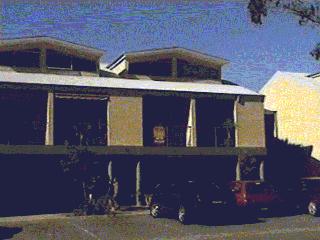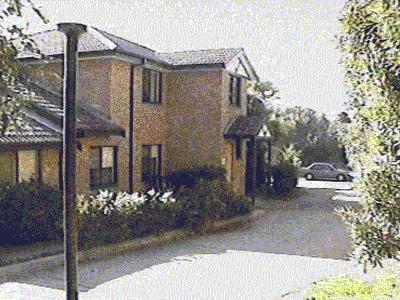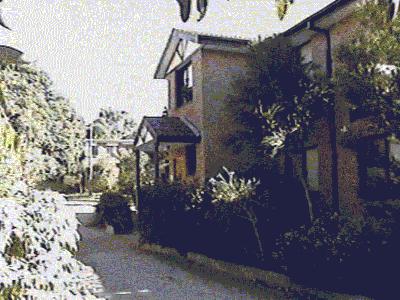Urban Villages - keep an open mind
Warringah aerial photo (Michael Paine)
by Michael Paine, Warringah resident
As featured in the Manly Daily, 19 June 1999.
c1999 Manly Daily
Warringah is a local government area on Sydney's Northern Beaches. The aerial photograph shows Dee Why Lagoon middle left, next to Dee Why Beach. Then Curl Curl Beach and Manly Beach. Sydney Harbour is at top right. The photo was taken during the campaign to save bushland at Red Hill.
Update: Warringah Counci's innovative LEP (1998) is no longer available. Here is an unofficial description. Thank you to John Mant for the concept of "desired future character".
It seems clear that the Allambie Community has totally rejected the concept of an urban village. There has been considerable misinformation spread about urban villages and I would like to set the record straight. Also I consider that the handling of the urban village issue by Council has left a lot to be desired.
First I should point out my association with the issue. In 1996 Warringah Council formed a Community Advisory Committee (CAC) to assist with the development of a new Local Environment Plan (LEP). I was the nominated representative of the Red Hill Preservation Society. The Society is principally involved in conserving Warringah's remaining bushland and protecting the water catchments. Members of CAC came from a wide range of backgrounds but it was clear from the first meeting that we recognised the precious character of Warringah, with its mix of built and natural features, and the need to have a clear plan to preserve and enhance this character in the coming decades.
Objectives of the LEP
One of the first tasks of CAC was to develop a list of objectives for the LEP. I am pleased that preservation of Warringah's bushland and waterways is prominently included in these objectives. Due to legal advice, the objectives are not included in the LEP so I have set them out at the end of this article. I am also pleased that the final LEP has come close to achieving these objectives - it is far from a "developers dream" because, compared with previous documents, it places many more controls on development in order to minimise impact on the community and the environment. On the other hand, it will be much easier for developers to come up with plans that are acceptable to the local community and to avoid wasting resources on designing unwanted developments.Dwelling targets
Early in its work, CAC accepted the reality that, in order to satisfy the State Government's residential strategy for Sydney, the new LEP would need to provide more dwellings in Warringah. The "low growth target" was about 7,000 new dwellings by 2021. However, there is a trend to fewer occupants per dwelling so the corresponding increase in population would be much less - and could possibly fall slightly.In essence, the options for creating more dwellings were:
On balance, the latter option was considered the most appropriate for the long-term good of Warringah. The urban village concept was therefore developed by Council staff as one method of achieving this option. This became an essential element of Warringah's residential strategy. As a result of this strategy Warringah gained exemption from the State Government's residential development policy - this was a very important breakthrough and put a halt to dual-occupancies.continue with the notorious dual occupancy ("duplex") provisions that the Government forced on Councils. The destruction of the character of our suburbs through these unchecked developments was a prime reason for the initiation of the new LEP. develop Warringah bushland areas. This was rejected because the natural areas of Warringah are seen as one of its greatest assets. Who wants to see it developed like the Eastern Suburbs of Sydney? provide mechanisms for more dwellings at locations which are hubs for shopping and transport.
In May 1998 CAC met with the Urban Design Advisory Service of the Department of Urban Affairs and Planning (DUAP) and discussed the urban villages concept. This concept is gaining popularity throughout the developed world as a means of limiting urban sprawl and giving people a choice of housing where they can walk to shops, professional offices and transport. The concept is particularly attractive for older people who can remain in the local community rather than move to a "retirement village" (under State Government policy SEPP5, retirement villages are generally built on bushland sites at the fringes of the suburbs - well away from shops and services). It also gives young people an alternative to moving into a unit or moving to an affordable house in Western Sydney.
It was also pointed out that Urban Villages would provide an opportunity to revitalise some of the neighbourhood shopping centres which, over the years, had suffered loss of business to major retail centres such as Warringah Mall. An example of this problem is at Beacon Hill where community shops and offices were demolished to make way for a fast-food outlet.
Despite these potential advantages CAC members were concerned about effects of urban villages on local communities. As a result the Draft Position Paper on Residential Strategies issued by Council in 1997 included the proviso that any proposal be subject to detailed planning covering issues such as effects on surrounding residents and existing businesses, built form, pedestrian accessibility, traffic management, public transport and public open space. In fact, the planning process for Urban Villages provides a good opportunity to address traffic and public transport problems
Sharing the "Windfall"
Concern that "developers were perched like vultures" to make profits was an issue at last week's meeting in Allambie. This was also of concern to CAC. During the meeting with DUAP's Urban Design Group in 1998 the concept of "Transferable Development Rights" was discussed. This is one possible mechanism for sharing the "windfall" resulting from a rezoning leading to a higher density development. In particular the advantages would not all go to a few fortunate land-owners. The system works by assigning a development right to all blocks of land within the nominated area. In the case of an urban village this might result in, say, all land owners gaining the right to build a second dwelling on their property - subject to the rules within the LEP. However, each land owner would be able to sell this right to another land-owner within the area. They would therefore have a choice of:Council would retain some development rights from the initial allocation for subsequent sale to developers. Council would be required return these earnings as local community facilities and road improvements. This concept could also work for other types of "rezonings" (such as Dee Why town centre and non-urban land) . It would provide better control of land speculation and it would probably be unpopular with land speculators. Unfortunately, the idea seems to have faded into the background within Warringah Councilstaying as a single dwelling and selling a "development right" to another land-holder staying as a single dwelling and holding on to their development rights (thus increasing their land value - an indefinite rate concession would be appropriate for current land-holders) or redeveloping their own site.
There has also been concern about land values dropping for properties surrounding a medium density development. In fact, the demand for well-designed town houses is so high that the opposite is likely to happen. In any case, transferable development rights would help to address these concerns.
Allambie Village
There has been no detailed planning of any urban village proposals in Warringah but I would have expected an urban village redevelopment at Allambie to involve refurbishment of the existing shopping area, with a plaza and perhaps 50 dwellings above the shops. Over a period of a decade or so the immediate surrounding area would have gradually been converted to townhouses. Most of the single dwellings on the outskirts of the area would have remained as they are - perhaps some would be rebuilt or renovated as single dwellings, possibly funded, in part, from selling a transferable development right. The total extra dwellings would have been, I would guess, between 200 and 300.In association with the redevelopment, Allambie would have gained a pedestrian plaza as a village centre, improved road access and improved public transport services.
Unfortunately, without the extra income from redevelopment in
the area, there is little incentive for a cash-strapped
Warringah Council to address these issues. It is all well and good to get a local
candidate elected to Council to fight for local issues but the
incumbent has a duty to serve the whole of Warringah and is
just one of nine votes. Even if urban villages are
rejected throughout Warringah we still have an unsympathetic
state
government demanding that Warringah takes its share extra
dwellings in Sydney. I am convinced that urban villages are the
least painfall way of doing this and that they provide
opportunities to make our suburban lifestyle better.
I urge residents in other areas to consider these potential benefits before they reject the urban village concept. If you think some of these ideas have merit then please let your local Councillors know - they are probably feeling uneasy about urban villages at the moment.
This article reflects the views of the author and does not necessarily reflect the policy of Warringah Council or the views of any other person or group.

.
.
Town Houses


.
.
.
.
.
.
.
.
.
.
.
DRAFT OBJECTIVES OF WARRINGAH'S
NEW
"PLACE-BASED" LEP
(These are not included in the legal document)
Natural Environment
a) To protect the visual qualities of the natural features of Warringah from inappropriate development and landscaping.b) To protect the streams, creeks, estuaries, foreshores and oceans of Warringah and enhance water quality in the various catchments within Warringah.
c) To protect flora and fauna habitats and wildlife corridors.
Built Environment
d) To achieve the desired character of the places that make up Warringah.e) To design for the safety and. security of the community.
f) To equitably share views and sunlight.
g) To design for privacy.
h) To protect the community from unreasonable noise.
i) To design using ecologically sustainable development principles.
j) To encourage quality and innovative urban design.
k) To ensure residential development has ground level open space for recreation, landscaping and water absorption.
Housing
1) To enable a variety of housing types at densities which comply with the desired character of the locality.Infrastructure And Transport
m) To ensure future development is appropriate to, and limited by, the constraints of available water, sewerage and stormwater infrastructure and private and public transport capacity. n) To facilitate development that complements existing public transport services, promotes walking and cycling and reduces the community's dependence on private motor vehicles.Economic Development
o) To encourage economic and employment generating development which is appropriate to the desired qualities and character of Warringah.p) To facilitate the renewal and redevelopment of retail/commercial areas to create vital and mixed urban centres.
Heritage And Lifestyle
q) To identify and conserve the natural and built heritage of Warringah.r) To facilitate the provision, retention and development of community, recreational and cultural facilities.
Hazards
s) To enable the assessment of risk, and ensure development is appropriate to, and limited by, the extent of hazard.Further resources
Several publications are available for viewing at Warringah's Libraries. The following sites are worth visiting (sorry but some links may no longer work):- Red Hill Preservation Society
- Warringah's environmental hotspots
- Warringah Council's Draft
LEP Position Paper 1997 (no longer available but see the
footnotes at Urban
Villages ~1999)
- An Urban Village for Pedestrians?? - Perth
- East Brunswick Urban Village , Cohousing Melbourne, Murdoch Uni , EPA, - Victoria
- Urban Village Policy in Victoria??
- Nature Conservation Council of NSW Bushland Mapping Project
Overseas Links
- Transfer of Development Rights (TDR) Information - Washington State, USA
- TDR Law - New York, USA
- TDR Law - Massachusetts,USA
- Resource for Urban Design Information (RUDI) - UK
- Interactive Engineering
- ASCE Urban Sprawl Forum
- Walkable Communities Inc.
- Liveable New York - catering from an aging population
- Sacremento Cool Community Project
- Energy-aware Planning Guide
- Nov 06: New Scientist: Geoffrey Miller forecasts the future - "This will, I hope, lead to revolutionary changes in urban planning, leading to a New Urbanist revival of mixed-use landscapes. Enlightened citizens will demand to live in village-type spaces rather than alienating suburbs of single-family isolation and unbearable commutes."
- 8 Jul 24 The Conversation: How
to ensure higher-density housing developments still have
enough space for residentsí recreation needs.